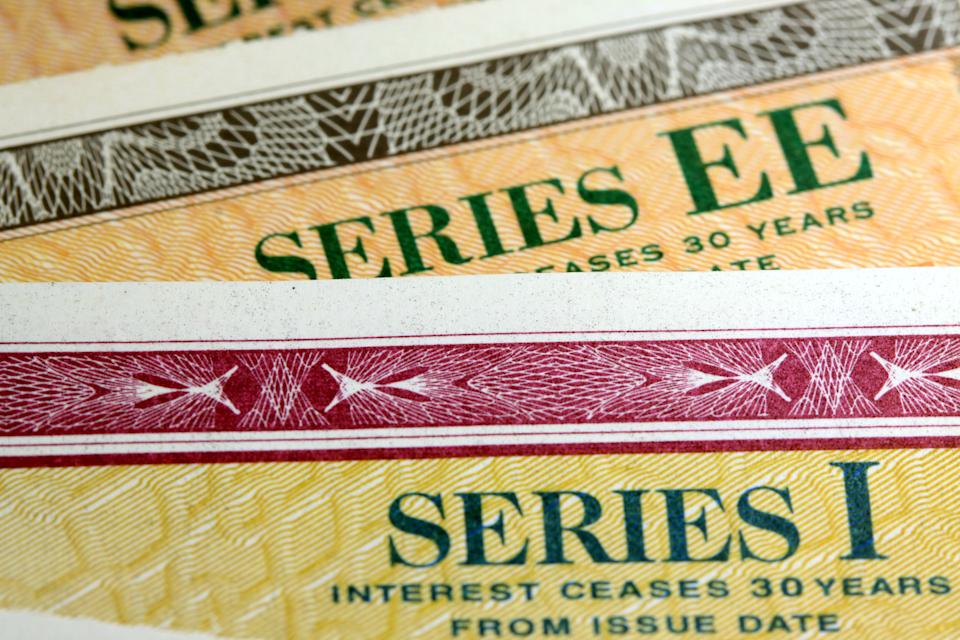Shaken by the double blow of high inflation and the sliding stock market, investors perked up when earlier this month the Treasury Department announced that the inflation-protected I bonds will earn a composite interest rate of 9.62% at least until the end of October.
Investing in Treasury inflation-protected U.S. savings bonds known as I bonds can be a smart strategy when the cost of living soars, particularly with banks paying rock-bottom rates on federally-insured checking, savings, certificates of deposit (CDs), and money market accounts.
But they can’t be a primary way to save or invest because of restrictions, experts say.
“Honestly, while they pay a high, positive rate, you can’t invest much money,” Lisa A.K. Kirchenbauer, a Certified Financial Planner and founder at Omega Wealth Management in Arlington, Va. told Yahoo Money. “I am fine with clients doing this, but it’s not a panacea.”

What are I bonds?
These bonds are government-backed and guaranteed to keep pace with inflation because their return is tied to the Consumer Price Index, and the interest is exempt from state and local taxes.
You can buy I bonds with no fee from the U.S. Treasury’s website, TreasuryDirect, in increments of $25 or more when you purchase electronically. Paper bonds are sold in five denominations; $50, $100, $200, $500, $1,000. They earn interest for 30 years or until they are cashed in, whichever comes first.
There are some restrictions. You must hold I bonds for at least 12 months before redeeming them. Moreover, if they’re cashed in before five years, the interest from the previous three months is lost.
In general, you can only purchase up to $10,000 in I bonds each calendar year. But there are ways to ramp up that amount, such as using your federal tax refund to directly buy an additional $5,000 in I bonds. A couple filing a joint tax return can buy up to $25,000 per year. Purchases that exceed the limit will be returned, but that refund could take up to 16 weeks, according to the Treasury Department.

Why do I bonds have such a good return?
The Treasury Department has a special sauce for the composite rate of return, though how the interest rate is calculated is somewhat confusing.
An I bond composite rate is a combo: a fixed rate set when the bond is issued, which stays the same for its 30-year life, and a variable rate, which is based on the six-month change of the Consumer Price Index and can reset twice a year, in May and November. The Treasury Department uses a formula to combine the two into a composite rate.
For example, if you buy an I bond on July 1, 2022, the 9.62% would be applied through December 31, 2022. Interest is compounded semi-annually. The rate also applies to older I bonds that are still earning interest.
That said, while the composite rate could drop to zero, and it has, it’s guaranteed not to fall below that — so you’ll be certain to get your initial investment back when you redeem the bond.
Not for retirement accounts
These returns are especially appealing given the alternative investment vehicles.

The national average interest rate for savings accounts is 0.06 percent, according to Bankrate’s most recent weekly survey of institutions. Money market account rates are averaging 0.08% and CDs return anywhere from 0.26% to just under a half-percent depending on the type and duration, according to Bankrate.
The stock market’s returns so far this year are even worse.
But I bonds go only so far as a solution. You can’t buy I bonds within a traditional IRA, Roth IRA, or employer-sponsored savings plan, such as a 401(k) plan. You’ll need to buy I bonds with savings outside of these programs.
“I bonds can help you protect your savings from loss of purchasing power,” Marguerita M. Cheng, a Certified Financial Planner and CEO at Blue Ocean Global Wealth, in Gaithersburg, Md., told Yahoo Money. “But you do want to make sure you have adequate cash reserves for any emergencies or opportunities that arise because there is that interest penalty if the bonds are redeemed in the first five years.”
Kerry is a Senior Columnist and Senior Reporter at Yahoo Money. Follow her on Twitter @kerryhannon
Read the latest personal finance trends and news from Yahoo Money.
Follow Yahoo Finance on Twitter, Instagram, YouTube, Facebook, Flipboard, and LinkedIn.
Source: finance.yahoo.com
